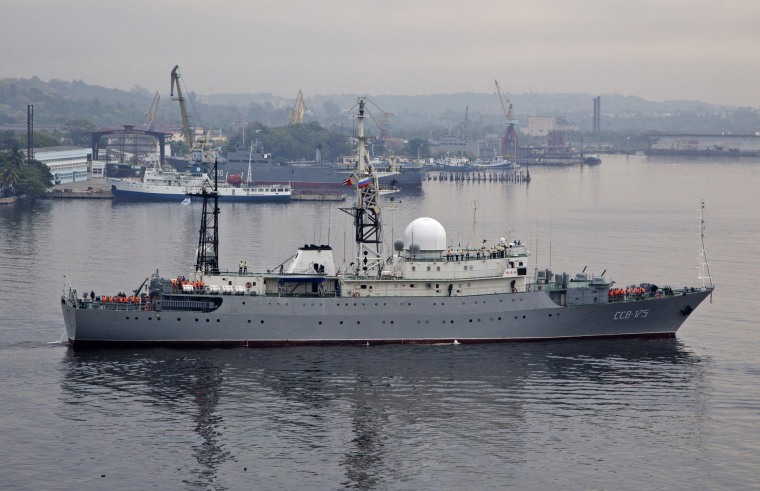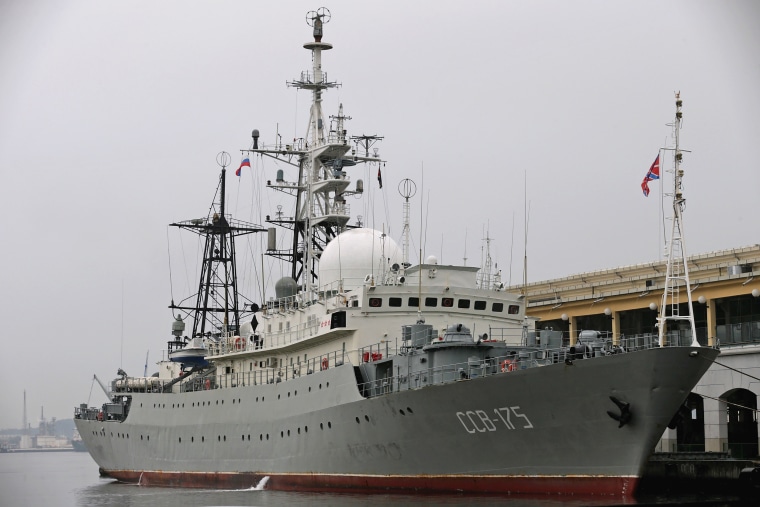Russia remains a threatening adversary of the U.S., but the country’s recent aggressive military actions aren’t signs of an imminent conflict, U.S. officials told NBC News
Traditional media and social media have been atwitter with reports of a Russian spy ship off Connecticut, the “buzzing” of a U.S. ship by Russian fighters and reports of new cruise missile deployments by Russia.
But U.S. military and intelligence officials said concerns about these incidents are, in the words of one, “highly overstated.”
“There are many facets to U.S.-Russian relations – and to Russia’s aggressive behavior – but on the military front, they are on the defensive almost everywhere,” a senior intelligence officer told NBC News. “Putin is indeed a menace to his neighbors, but outside Crimea and Ukraine, Russia is contained and playing catch-up.”
About That Spy Ship
For the experts, the presence of the SSV-175 Viktor Leonov off the coast of Connecticut is a sign of Russian weakness, not strength.
After all, the spy ship’s limited and outdated electronic eavesdropping gear can only listen to radio communications -- ship-to-ship, ship-to-shore, and commercial radio broadcasts.
“I hope they are having fun listening in on Classic 101,” a Coast Guard officer from the New England district added, asking for anonymity because he is not authorized to speak on intelligence matters.
The Leonov is “not a threat,” a senior intelligence official told NBC News.

“It’s proof of Russian weaknesses vis a vis the United States,” the source said. “It demonstrates the rudimentary nature of Russian electronic eavesdropping and how far behind the U.S. they are in global surveillance. “
“The ship specializes in listening in on radio transmissions, not digital communications, which makes it virtually unable to collect any sensitive military or intelligence communications.”
The Russian spy ship, officially called an AGI, was in transit towards the Northeast U.S. for weeks before its arrival off Connecticut. Its mission was routine, said a U.S. military official and a U.S. intelligence officials.
A third intelligence official said that the presence of a Russian AGI off the coast has been a constant for decades but that current frequency is nowhere near Cold War levels. The Leonov last made an appearance near the U.S. in 2015.
The Leonov also transited entirely in international waters. “So it’s perfectly legal,” said the official.
On this recent mission, the Leonov began to steam north from Cuba in mid-January and generally stayed about 70 miles off the U.S. coast. It went as far north as Connecticut on Wednesday. It is now heading back south.
The 'Buzzing' of U.S. Ships
The Pentagon reported that the destroyer USS Porter was “buzzed” last week in the Black Sea by Russian planes, which flew within several hundred yards of the ship.
But U.S. officials say there’s more to the story. The Porter, configured as a lead ship in the European missile defense network and with various espionage capabilities, lingered within 40 miles of the Russian coast before the incident.
Officials noted that the Porter, like the Leonov, qualifies as a spy ship -- but with far greater capabilities.
The U.S. Navy calls the Porter “the most technologically advanced [ship] in the world.” Its combat system is configured to act as coordinator for the new regional ballistic missile defense system in southern Europe.
The Porter has the latest generation Ship's Signals Exploitation Space (SSES) and “Red Falcon,” which are offensive cyber and intelligence systems, according to Navy documents.
“These ships are an integral part of the European ballistic missile defense shield,” a naval intelligence officer told NBC News. “To the Russians, this is the most annoying element of U.S. capabilities that has been deployed since the annexation of Crimea.”
The land-based systems, including intercept missiles, are already active in Romania and are being built in Poland. A further new early warning radar is in Turkey.
The Porter incident was not as serious as that of its sister ship, the USS Cook, in the Baltic Sea. In April 2016, two Russian fighters flew within 30 feet of the Cook in a simulated attack profile. The Cook was on a mission almost identical to the Porter’s, lingering 40 miles off the heavily militarized Russian enclave of Kaliningrad.
The Russians also have close encounters with U.S. aircraft over Syria on a regular basis, officials said – with incidents several times a month.
The Cruise Missiles
The suggestion that Russia violated its treaty obligations by deploying a land-based cruise missile is also a complicated matter, officials and private analysts told NBC News.
The U.S. has long been aware that the Russians have been preparing new cruise missiles.
Starting in 2014, the Obama administration flagged a new Russian cruise missile under development as a violation of INF Treaty. President Obama sent a letter to Vladimir Putin about the alleged breach.
The new missile, designated SSC-X-8, was first flown in September 2015, and the U.S. condemned the tests.
In November 2016, the two sides met under the INF verification framework in Geneva, but there was no agreement. Moscow then deployed the weapon, now referred to as the SSC-8, the elimination of the “X” designating it as operational.
One defense official told NBC News that the Russians have assigned the system to a unit based inside Russia. So while it is now believed to be operational, it has not left the country.
The U.S. maintains the missile is a violation. Dmitry Peskov, spokesman for Putin, said the U.S. has not made a formal complaint.
Hans Kristensen, director of the Nuclear Information Project at the Federation of American Scientists, said the question is not settled. “Whether the missile is operational, what variant it is, and how it might violate the INF Treaty is still wide open to debate.”
Kristensen said the deployment could be seen as a Russian response to the U.S. deployment of new conventionally-armed Joint Air to Surface Missile (JASSM), which the Kremlin sees as a potential provocation. The U.S. has deployed the new missile on its own strategic bombers, some missiles are already deployed in Germany, and more are being sold to the Polish and Finnish air forces.


